Elective Endovascular Occlusion of Brain Aneurysm
What is a brain aneurysm?
A brain aneurysm is a weakness in the wall of one of the blood vessels supplying blood to the brain. This causes a ‘’blister’’ or balloon like swelling on the blood vessel.
Some aneurysms pose a greater risk of bursting and so causing a brain haemorrhage (subarachnoid haemorrhage). Treatment is offered for these aneurysms to secure them from bleeding.
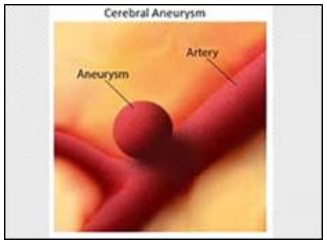
(Diagram of brain aneurysm)
What is coil occlusion of aneurysm?
This is an endovascular treatment which means it is performed through a blood vessel (artery) by a consultant interventional neuro radiologist. It is carried out whilst you are asleep under general anaesthetic.
A catheter (tube) is inserted into an artery in your groin or your wrist in the same way as an angiogram. The catheter is fed up through the arteries to the aneurysm using x-ray screening. Dye (contrast) is injected into the artery to allow the blood vessels to be seen on large x-rays screens which will allow the aneurysm to be treated safely. The coils are then deposited inside the aneurysm. The size, shape, and position of the aneurysm will determine which type and how many coils are used.
The aim is to pack the aneurysm with coils so that blood is not able to enter it, and so allowing the aneurysm to seal over.
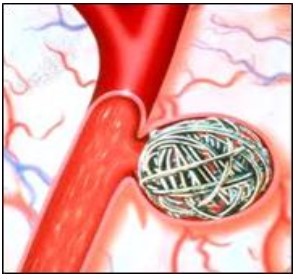
(Coils inside the aneurysm)
What is ‘stent assisted’ coil occlusion?
Stents (artificial tubes) are also used with coils or on their own to seal off aneurysms. These are used depending on the type, shape and position of the aneurysm.
A stent is a soft, flexible mesh tube made of metal that is placed inside the artery. Stents vary in size and structure: They can be used on their own or with coils to seal off aneurysms.
Flow diverting stents re-route blood flow away from the aneurysm allowing it to seal off.
You should have clear instructions on the medication such as aspirin and any other antiplatelet (blood thinning) tablets you may need to take afterwards before you go home. Please ask your medical team, nurse specialist or ward nurse for this. You should not stop this medication unless you are advised to do so by your medical team.
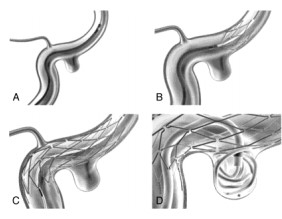
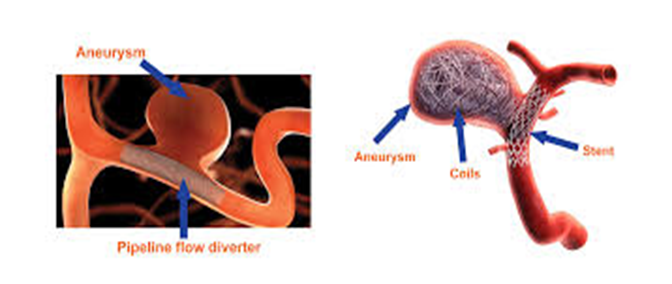
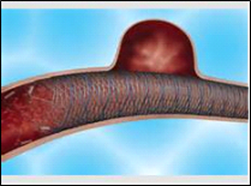
What is a WEB occlusion device?
A WEB (or woven endobridge) is a soft, mesh sphere made from braided metal that is placed into the aneurysm and self-expands to seal it off. They come in various sizes and your aneurysm is measured prior to placing to secure the ideal fit.
WEB occlusion device
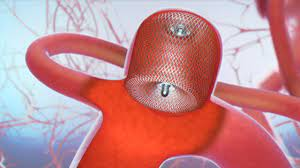
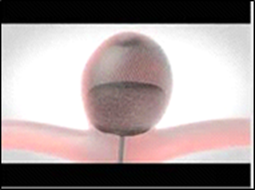
Other methods to occlude aneurysms by endovascular means
This area of medicine is continually changing and newer devices are becoming available all the time
What happens before the procedure?
You are generally brought to pre op clinic to be assessed and allow you to ask questions regarding the procedure. This clinic visit usually lasts up to 2 hours as a detailed clinical history and examination takes place: you will then have tests such as blood and urine tests, completed to ensure your safety for the procedure and the general anaesthetic.
The dye that is used to view the arteries is flushed away naturally when you pass urine. You should drink 2 litres of water 2 days before the procedure and the day before as well as the day after. This is to prepare your kidneys to flush out the dye used during the procedure and so aid your recovery.
You normally come in the same day as the procedure at 7am in the morning. Unless there are plans for you to come in the day before, you should make your way to Jefferson day ward.
The night before the procedure you should not eat any food from midnight. You can sip water throughout the night until your procedure. You should take your normal medicines in the morning unless you have been told to withhold them at pre op.
You may have some blood taken before the procedure.
You will normally start anti platelet medication up to 7 days in advance. These drugs are most commonly aspirin and clopidogrel although others may be chosen. The purpose of these drugs is to reduce the risk of the blood clotting during the procedure which increase the risk of stroke and so it is important you take them.
If you have certain medical conditions, you may need to come in the day before.
Every effort is made so that you can have your procedure on the planned day but unfortunately, if another patient comes in as an emergency, your procedure may need to be postponed. Emergencies will always take priority.
Although you are not likely to need one; if there are no intensive care beds your procedure will be cancelled as your safety is our priority.
We will make every effort to prevent cancelling your procedure. If it is cancelled, you will normally go home and return a second day.
What happens during the procedure?
Coiling is a complex and delicate procedure that may take a few hours or longer. The interventional neuro radiologist makes a small cut in your groin and inserts a catheter (tube) into your femoral artery in the groin or radial artery in the wrist. This is then guided by x-ray screening through blood vessels in your body until it reaches those in your neck and then your brain. The coils are then carefully inserted into the aneurysm to fill it and so prevent blood entering it, thus sealing it off. Coils are made of platinum, and about double the thickness of human hair. The length of them varies. The number of coils needed depends on the size of the aneurysm
Stents are placed in a similar way but sit in the artery adjacent to the aneurysm diverting blood flow away from the aneurysm.
WEB devises are inserted into the aneurysm and expand to fill it snuggly thus preventing blood from entering
What happens after the procedure?
After your aneurysm is treated, you will spend some time in the post-operative care unit (POCU). You will be assessed and go to a ward once it is safe to do so. Sometimes, however, it is necessary for you go to the critical care unit where there are more facilities to treat and monitor you. This may be because the procedure was long, complex or certain treatment is necessary. This is the reason we do not normally start a procedure if there are no critical care beds.
Once back on the ward, you will need to lie down on bed rest for 6 hours. This helps to minimise the pressure on the artery that has been used to access the aneurysm.
You will have regular observation of your limb strength, conscious level, blood pressure and pulse, as well as the puncture site. You will have a drip to make sure you don’t get dehydrated. Once the drip is out we will expect you to drink plenty the next day to wash out the contrast (dye) used in the procedure. You will have stockings or compression devices on your legs. You will normally have blood thinning injections after the procedure until you go home. This is to prevent venous clots (D.V.T.’s) in your legs whilst you aren’t moving around as much and are discontinued when you get home.
You will normally be placed on Aspirin and/ or a second anti-platelet tablet after the procedure depending on what has been done.
You will be allowed to gradually sit up after 6 hours and gently mobilise with supervision if the nurse looking after you feels it is safe to do so.
The puncture site in your groin is sometimes painful afterwards. There may be some bruising or swelling. Occasionally this can be excessive. If you notice this then you must let your medical team know. The site should not bleed afterwards.
It is advisable to hold this area whilst coughing or straining afterwards if possible. Instructions on looking after the puncture site are included towards the end of this booklet
What are the risks of endovascular procedures to occlude aneurysms?
The procedure will not be carried out unless the benefits outweigh any possible risks. You will have discussed the procedure and risks with your neurosurgeon/ interventional neuro-radiologist and given your consent before you go ahead with the procedure.
The common risks of coiling are complications that include stroke-like symptoms such as weakness or numbness in an arm or leg; problems with speech or problems with vision.
There is also a risk of bleeding, infection or arterial damage at the entry site in the groin. In rare cases the damage to the artery has to be repaired through another operation.
There is a risk you may have arterial damage such a small tear at another place in your body or brain.
There is a small risk associated with the radiation (x-rays) used to treat aneurysms. We are all at risk of developing cancer during our lifetime. The normal risk is that this will happen to about 50% of people at some point in their life. Radiation received from undergoing this type of intervention will increase the chances of this happening to you from 50% to somewhere in the range of 50.01% to 50.0001%
Hair loss
Very rarely small patches of hair loss can occur after any treatment involving x-rays. The hair usually grows back.
If you do lose some hair, you should use gentle shampoo only and not use strong chemicals such as dyes, perms and strong hair products
If this happens to you, you should let us know.
When will I go home?
Once your medical team are happy that you no longer need treatment you will be allowed to go home. This is often the day after the procedure if there are no complications.
You may have had a baseline magnetic resonance (MRI) scan before you go home. If this cannot be fitted in and you are ready to go home then your medical team may allow you to come back for it as an outpatient.
You will normally go home on a course of anti-platelet medication such as aspirin and/or clopidogrel. You should have instructions on the dose, side effects and length of time you should take these before you go home.
Aspirin can sometimes worsen indigestion or heart burn and may make breathing worse in those with asthma. Occasionally, it can cause bleeding or skin reactions. If these side effects occur seek medical advice. Clopidogrel can rarely cause stomach upset and bleeding problems.
In the rare event you get excessive bruising or bleeding please contact us for further advice. If you consider it serious contact your GP or local A+E.
If you do bruise excessively, you may need a blood sample taken to check on your blood clotting. This type of test can only be done at the Walton Centre but it allows us to alter medication according to how sensitive you are to it.
DO NOT STOP ASPIRIN OR CLOPIDOGREL WITHOUT TELLING US.
IF IT IS STOPPED BY ANOTHER DOCTOR, THEY, (OR YOU) SHOULD LET US KNOW WHY. THIS IS BECAUSE IN SOME CASES, STOPPING IT MAY CAUSE YOU TO BE AT RISK OF A STROKE
Can the coils move?
The coils may settle into the space within the aneurysm. This is called coil compaction. This may mean that more coils are required to seal off the aneurysm fully. Alternatively, the situation may simply be kept under surveillance if your doctors feel the aneurysm remains is safe from bleeding.
Follow up
You will usually be reviewed in a video clinic at around 2-3 months after your procedure.
You will normally have an MRI scan after 6 months, 18 months and 5 years although this can change according to individual circumstance.
If a stent is inserted or the aneurysm need to be reviewed more closely then you may need an angiogram as part of your follow up.
Some advice for recovery
Whilst there are no scars from this procedure please be aware that you may need time to recover as it is a complicated intricate procedure. You may feel a little ‘under the weather’ or tired for a few weeks following the procedure.
If you have a stent inserted you may feel under the weather or experience headache for a few days whilst it settles into the artery.
Headaches
Headaches may occur following the procedure and usually ease after a few days or rarely weeks. Simple medication such as paracetamol should help. Headaches can be triggered by dehydration, stress, illness, too much or too little sleep and missing meals. Drinking 2-3 litres of water a day, regular meals, ensuring good sleep pattern and in some instances avoiding certain triggers (caffeine, alcohol, cheese etc) can help.
There are also some options such as menthol sticks to rub on the forehead which may help reduce the frequency and severity.
Prolonged or regular use of analgesia (paracetamol, ibuprofen, codeine, morphine etc.) may also worsen or prolong headaches so should be used sparingly and stopped if no longer required.
If the headache does not improve you should seek medical advice
Pacing
Recovery is helped by pacing your activity for the first week or so following going home. Take a daily rest as well as some gentle exercise. Build up activity as you improve
Returning to work
You can return to work as soon as you feel able although most people need about 1-2 weeks off to recover. (Occasionally more if there have been complications). If you have a manual job, you must not lift for 10 days after the procedure
Unusual sensations
Some people experience unusual sensations in their head following coiling of aneurysm. Some examples are ‘cotton wool’ sensation or ‘water trickling’. We are not sure why this occurs, but they should ease with time.
Fear of the aneurysm bleeding
This is a very common fear for a lot of patients after an aneurysm is sealed off. Unfortunately the risk is real but it is extremely small. Because the aneurysm cannot be taken away, it is important to learn a coping strategy. Remember, you will be followed up and scanned regularly once you have gone home. You will only be discharged from the Walton Centre when the experts think it safe to do so.
Commonly asked questions.
Driving
You do not normally have to inform the DVLA following this procedure unless there have been complications. You should always check driving advice with your medical team before you go home. If your recovery is straight forward, you should not drive until you feel recovered and go out on a quiet road on a quiet day to see how you manage. This is because driving involves many different cognitive and physical skills as well as multi-tasking, decision making and problem solving.
Flying
If you have had coil occlusion of your aneurysm, you should be able to fly as soon as you feel able. It is safe to go through the metal detectors in the airport. They will not affect the coils or clips. You should always inform your insurance company before flying.
Smoking Cigarettes
As cigarettes are one of the biggest risk factors in development and rupture of aneurysms it is advisable that you give up smoking completely. You are advised to stop smoking cigarettes if you have a stent placed: If you continue to smoke against advice, there is a risk of the stent narrowing which can cause stroke like symptoms or even permanent stroke.
A free help line number is printed at the end of this booklet
Drinking Alcohol
Whilst alcohol in moderation within government guidelines is acceptable it is advisable you reduce the amount you drink if excessive.
We do not advise alcohol whilst taking two antiplatelet medications (after a stent)
Information websites on alcohol awareness is printed at the back of this booklet.
Sexual Activity
You can resume normal sexual activity as soon as you feel able.
Starting a family
It is advisable not to start a family for the first 6 months after endovascular treatment. This is because the aneurysm needs time to heal and medication you have to take following certain treatments such as stents may be harmful for your baby. These medications cannot normally be stopped.
Your obstetrician will discuss with your neurosurgeon if specific advice is needed following treatment but we generally only advise that the second stage of labour is not prolonged.
You will not normally have M.R.I. scans whilst you are pregnant.
Sport and swimming
Most sports can be resumed gradually once you have recovered and the puncture site in your groin is healed; usually after 2 weeks.
It is best to avoid extreme and contact sport until you have had your 6 month follow up scan.
Hair Washing and hair dyeing
You can wash your hair as soon as you feel up to it. The coils will not be affected by dyeing or perming your hair.
Dental Treatment
Dental treatment is safe after coiling of aneurysm but your dentist may not be happy to treat you whilst you are taking aspirin and/or clopidogrel and we won’t normally advise it is safe to stop. If treatment isn't urgent you should wait until the course finishes.
Please contact us/ your treating doctor for further advice if you need treatment whilst taking aspirin or clopidogrel.
ADVICE FOR CARING FOR PUNCTURE SITE TO GROIN/WRIST POST OPERATIVELY.
If the problem is considered serious, help should be sought from your local accident and emergency department immediately. Otherwise, you should contact your G.P., NHS direct or visit your local walk in centre.
- Do not strain or lift anything greater than 10lb for 10 days following angiogram
- Drink plenty of water or juice 24 hours before and 24 hours after the angiogram to prepare the kidneys and flush the dye from your body (about 2 litres or 10 glasses)
- Do not drive or operate machinery for 24 hours following angiogram
- Do not do any physical exercise or sexual activity for 24 hours following the angiogram.
- Keep the dressing on, clean and dry for 24 hours following the angiogram
- After 24 hours the dressing can be removed and a shower (not bath) can be taken. A bath and swimming is allowed once the site is fully healed.
- Clean and inspect the site and wash with mild soap and water. Dry and re-cover with a plaster until it is healed completely
- Report to A+E if the site bleeds and not stopped after 15 minutes of firm (but not excessive) manual pressure.
- Report to your doctor/ us/ A+E depending on the severity if there is any swelling; change in colour (paler or darker); change in temperature or change in sensation to the leg/hand.
- Report to your doctor urgently if there are any signs of infection such as redness, pain, swelling or pus from the site.
- Report to your doctor/ us/ A+E depending on severity if there are signs of excessive new bruising (a small amount of bruising is expected from the procedure).
- If you have a new lump in at the site of the angiogram puncture which pulsates you should cover it- do not mobilise and must have it seen to urgently: either go to A+E or inform us
- If you have had a puncture in the groin and develop pain in the abdomen (flank) on the side of the angiogram you must attend A+E or speak to us urgently
Contact details for verbal advice following angiogram;-
Verbal advice is available 24 hours a day / 7 days a week.
Written advice in elective pre-op clinic
Medications to stop (and date):
…………………………………………………………………………………………………
……………………………………………………………………………………………………..................................................................................................................................
…………………………………………………………………………………………………
Aspirin and clopidogrel:
ASPIRIN:
From ………………………………………………
Until………………………………………………..
CLOPIDOGREL:
Form ……………………………………………..
Until ……………………………………………..
Please take 30 minutes after food – can cause indigestion/heartburn and increase bruising or bleeding. You will need to take this medication on an empty stomach on the day of your procedure.
If you have any concerns when taking these medications please contact neurovascular nurses on 0151 556 3325.
Please fast after midnight (night before procedure) and sips of water until you go to theatre.
Drink 2 litres of water on the ……………………………………….
COVID swab date ………………………………………………….
Start Hibiscrub 3 days before procedure.
You will complete a consent form on day of procedure.
Any changes after pre-op regarding your health please contact neurovascular nurses 0151 556 3325
We don’t advise you bring anything too valuable into the hospital although small items that can be locked up are OK
If you develop any cold like symptoms, signs of a chest infection, symptoms of a urine infection or develop vomiting and diarrhoea you must inform the neurovascular nurses on 0151 556 3325.
Useful Contact details
NHS 111: 111
Telephone advice if you need urgent medical help fast but it is not a 999 emergency (or you do not have a GP)
Website: http://www.nhs.uk and search ‘emergency and urgent care’
D.V.L.A. Driver Vehicle Licensing Authority,
Drivers Medical Group, DVLA, Swansea, SA99 1DL.
Medical Enquiries: 0300 790 6806
www.dvla.gov.uk
Brain Haemorrhage Support Group affiliated to Walton centre:
bhsupport@live.co.uk
Facebook or via Brain Charity
The Brain Charity: 0151 298 2999. www.thebraincharity.org.uk
Working Life Service at The Brain Charity: 0151 298 3288
Department of Work and Pensions: 0345 606 0265 https://www.gov.uk/government/organisations/department-for-work-pensions
Access to Work for support if you have a disability or health condition: https://www.gov.uk/access-to-work
NHS Quit smoking helpline:
England: 0300 123 1044 https://www.nhs.uk/better-health/quit-smoking/
Wales: 0800 085 2219 https://phw.nhs.wales/services-and-teams/healthy-working-wales/health-and-wellbeing-workplace-guidance/substance-misuse/help-me-quit/
Advice on Alcohol: www.drinkaware.co.uk or www.drinkingandyou.com
- Last Updated:26 January 2023
- Review Date:26 January 2025
- Author:C Stoneley. (Neurovascular ANP )
- Summary:
A brain aneurysm is a fault or weakness in the wall of one of the blood vessels supplying blood to the brain.